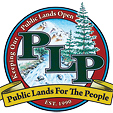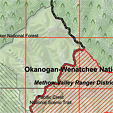Legislation & Regulation
MMAC Update
April 2017 by Scott Harn
I arrived in Washington, DC, in early March for our second trip in less than four weeks, but the schedule this time allowed for much greater progress in our efforts to restore mining as a priority for public lands.Back in March 2016, Minerals and Mining Advisory Council (MMAC) National Advisors Clark Pearson and Joe Martori spent a week educating members of Congress about Mining Districts and highlighted the important, forgotten role Mining Districts played in our history.
Over the course of 36 meetings they found strong support from members of the House Committee on Natural Resources and the House Armed Services Committee. All were in agreement that the current regulatory burden has made it so difficult to locate, explore and extract a valuable metal or mineral that our inability to produce critical minerals and metals in the United States has become a national security issue.
MMAC had already been working on a proposed 20-page bill to address many of the needs of miners, including access, oversight, arbitration and more; and by “working” I mean there was some serious effort involved, including 42 revisions. Over the next eleven months MMAC worked with Congressman Cook (R-California) and his staff, and at their request the bill was scaled down to include just a few of the main issues and written in a format for possible inclusion in the National Defense Authorization Act.
This second bill went through eighteen revisions of its own, and made several trips through legal counsel at the House of Representatives.
In February 2017, I joined Clark Pearson and Joe Martori for a return trip. This included another thirty-three meetings with Congressmen and their staffs, and I gave an in-depth report on this trip in our March issue. To briefly recap: what was immediately evident was that we needed to start over in some respects because there had been so many changes following the recent election. There were new members on the various House committees we needed to educate, staff changes for some of the Congressmen, staff changes in the legal counsel for the various committees, and even support staff who moved from the House to the Bureau of Land Management and Fish and Wildlife.
Capitol Hill was still in a bit of disarray, with confirmations of President Trump’s nominees being held up, and many departments still without a leader and top level staff. However, the attitude in Congress has improved significantly since the election when it comes to getting things done related to public lands.
After many, many hours of meetings, we left optimistic but a bit frustrated because we still didn’t have a clear cut path to getting our bill through and a definite date it might happen.
On March 7, Clark, Joe and I headed back to Washington, DC, but this time we were invited by a gentleman who I will refer to as our “guide,” who assisted President Trump during his transition. Karen Gentile, a fellow mine owner in southern California and member of Women in Mining, joined us to provide some additional perspective. It became immediately apparent our guide had plenty of knowledge and experience with public lands issues. He had set up, in advance, meetings with influential Senators and Congressmen who handle matters related to public lands and a meeting with the Department of Interior.
There were twenty-four participants who were invited for this trip, all with issues related to public lands.
We began with a few meetings we had scheduled independent of the rest of the group, and found Representative Mike Coffman (R-Colorado) extremely helpful. We had already met with his staff on our previous trip and they were supportive of our efforts. We went over our plans with him directly, and he wrote a letter on our behalf to get us in front of the appropriate committees.
We spent the rest of the morning and early afternoon in pre-scheduled meetings with influential Congressman. We talked strategy with Senator Mike Lee’s (R-Utah) staff regarding several public lands issues. Senator Lee is still quite angry over former President Obama’s declaration of a national monument in his home state, which was done against the wishes of legislators in Utah and he is in favor of local control of roads and routes.

Later that afternoon we headed into the Capitol Building for the Western Caucus meeting, “A Vision for the West.” Representative Paul Gosar (R-Arizona) and Senator Steve Daines (R-Montana) are the current chairmen of the Western Caucus. They spoke about prior abuses of the Antiquities Act, Endangered Species Act reform, agency overreach, grazing issues, climate change, and more. Only reporters were allowed to ask questions at this session.
I was skipped over during the question and answer session, but it turned out to be to my advantage. I complained to the coordinator when the session was over and identified myself as the editor of the Journal, so I was granted some one-on-one time with Congressman Gosar.
I briefly went over the congressionally-granted authority of Mining Districts and our smaller proposed bill, and he agreed to give us some more time back at his office a few days later to go over it in depth.
We spent our evening at some informal get-togethers at two private residences in the DC area, which provided the opportunity to talk with staff members from Congress, other agencies, and a few consultants working on public land issues. We found common ground with many of them, and found a strong ally in a former Congressman turned consultant who agreed that Mining Districts provide the smartest legal route to reopen closed routes and roads, to remove overzealous regulations and to restore the rights of miners. We are now working with his staff to get our bill pushed through in an expedited manner.
The next day we had a face-to-face meeting with five recent Trump Administration appointees. Part of our agreement was not to mention details of this meeting so I must abide by that agreement—I can only say that change is coming at the Department of Interior.
In the afternoon our guide obtained a meeting room within the House of Representatives and staff from numerous members of the House and Senate who, for the most part, share similar goals regarding public lands, came to us. They answered our questions and listened to our concerns on a whole range of issues.
The following day our guide hosted an all-day brainstorming session where we listed the top problems that need to be addressed in the public lands arena and proposed ideas for fixing those problems. We split into teams and we’re working on those issues through email and conference calls.
I had to head out on Sunday afternoon. Clark and Joe had an additional meeting back at our hotel with the staff of the retired Congressman who volunteered to assist us. Joe moved his flight back another day so he could attend an extra meeting Monday with Congressman Gosar.

It was a very satisfying experience this time. We made significant progress and I believe we have the support needed to get our first bill through Congress.
How Will This Bill Help Me?
Our first bill will clarify what a traditional Mining District is and change the current regulatory structure. Mining Districts will be the entity that decides whether or not a road or route should be open and will jointly govern mining on public and federal lands via a Memorandum of Understanding with the Bureau of Land Management.Excerpt from the bill:
(3) MINING DISTRICT.—Mining Districts are local independently organized governing authorities, recognized by the Department of the Interior through a Memorandum of Understanding (MOU) with the Bureau of Land Management (BLM), for the joint and exclusive minerals and mining management on the public and federal lands of the United States, recognized under 30 U.S.C. § 22; subject to other federal and state laws the local Mining Districts determine, do not unreasonably materially interfere with mining claimants right to possess, explore, prospect, develop and extract, pursuant to 30 U.S.C. § 612(b).
The “joint and exclusive” language is to remove local and state agencies from the process. Suction gold dredgers would no longer need a state permit after this first bill passes. If challenged by state officials, the MMAC-assisted Mining District would issue their determination and the local sheriff or US Marshall could be utilized for intervention on your behalf if needed.
There is obviously more in the bill and it’s still a work in progress. It’s being refined a bit further to ensure the wording is correct to prevent legislation from the bench in courts like the 9th Circuit.
What Can I Do?
First off, if you are mining in Arizona and are part of a traditional Mining District, please send me a summary of the issues you are currently dealing with. You might highlight problems with access, permitting, or a similar mining-related issue with a state or federal agency.I’m asking for these letters because Congressman Paul Gosar (R-Arizona) is seriously considering sponsoring the legislation. Keep your letter short, polite, concise, and no more than a page if possible. Address the letter as follows:
(Insert Date)
Congressman Paul Gosar
504 Cannon HOB
Washington, DC 20815
Honorable Paul Gosar:
You can end the letter with something like, “Please assist MMAC in getting their important bill through Congress.” Don’t forget to sign your letter and include your mailing address. You can send completed letters to me by mail at: ICMJ, PO Box 2260, Aptos, CA 95001. Or you can email them to editor@icmj.com. (Please put “Letter for Congressman Gosar” in the subject field.) MMAC will deliver these to Congressman Gosar.
The second thing you can do is support MMAC. You can join for a year as a gold (claimholder) member for $110; join as a silver member for $35; or just make a one-time contribution at mmacusa.org.
I’ve paid my own way for each of the trips to DC, but the other national advisors cannot afford to do so. We will need to return to Capitol Hill several more times this year to get these bills through Congress and we need your financial support.
And last but not least, you need to get your traditional organized Mining District in order and registered with MMAC if it’s in disarray. When the first bill passes, MMAC-assisted Mining Districts will be formally recognized and will return to their place of prominence.
I’m going to repeat some information I’ve included in past articles because it’s important. Here are the steps you need to follow to get your Mining District in order and retake control:
- Look up or locate the name for the Mining District where your mining claims are located. Keep in mind that the name may have changed over time and it may have been located in a different county originally. You may have more than one name to research. (www.westernmininghistory.com is a decent place to start, along with historical maps and books that can be found on the Internet.)
- Track down the original bylaws. We have the bylaws for about 190 traditional Mining Districts on our website. You can start there by looking for “Bylaws for Traditional Mining Districts” under the “Resources” tab at www.icmj.com. Other sources could include the county recorder’s office where your claims are located, local mining museums, historical societies, universities and the Internet. Many of these Mining Districts were established in the 1850s or 1860s, and county boundaries and names have changed since that time, so look for older historical documents for clues. Make copies of any original bylaws you find. If you cannot find the bylaws, photocopy papers that mention the Mining District and look for anything that might show the boundaries.
- Attempt to contact other claimholders in your traditional Mining District. You can do this through the Bureau of Land Management office for the area where your mining claims are located.
- Find a location in or near the Mining District where you can hold a meeting of claimholders for that Mining District. (You’ll need five claimholders to make a quorum.)
- Contact MMAC. If we have a MMAC administrator available in your area, he or she can guide you through the process, and provide you all the necessary paperwork to become a MMAC-assisted Mining District. He/she may also be able to attend your first meeting.
- Set a meeting date near the area where the Mining District is located—preferably about two months out to give claimholders time to make arrangements.
- Publish a Public Notice. (ICMJ’s Prospecting and Mining Journal will publish it for $65.)
- Conduct your meeting, elect officers, and take appropriate notes. You need to be a claimholder to vote. Many of you have been a member of a club or organization and know how to conduct this process. If you don’t, find someone who can help. “Robert’s Rules of Order” is also a good reference and can be located online at www.robertsrules.org.
- Securely post signage at all the major entry points to your district.
- Encourage claimholders in neighboring Mining Districts to get organized if their district is in disarray.

Legislative and Regulatory Update
• It's almost November
• Two federal land managers found guilty of contempt
• A chance to halt additional wilderness in Southern California
• Oregon mineral withdrawal
• A really good reason to get out and vote in Oregon
PLP Update: Another Suction Dredge Case Heading to the US Supreme Court
 In the meantime, we will continue our multi-pronged approach to seek regulatory relief at the federal level while supporting those court cases that are built on a strong legal foundation.
In the meantime, we will continue our multi-pronged approach to seek regulatory relief at the federal level while supporting those court cases that are built on a strong legal foundation.
Proof Mining Districts Work!
 If you need more proof that having an organized Mining District can help you, look no further than the recently proposed Methow Headwaters Withdrawal in north-central Washington State.
If you need more proof that having an organized Mining District can help you, look no further than the recently proposed Methow Headwaters Withdrawal in north-central Washington State.
Legislative and Regulatory Update
• Extremist groups are at it again
• Trump-era actions on endangered species being reviewed again.
Our Readers Say
“When dealing with federal agencies...”
Legislative and Regulatory Update
• BLM proposed budget asks for funds for mining restrictions
• Oregon bill 838
• California suction gold dredging update
Constitutional Sheriffs Standing Up for Our Rights
Modoc County, California, is the latest county to use emergency powers to declare a state of emergency in order to take control of roads and trails away from federal agencies.
Subscription Required:
The Bawl Mill
• Legislative and Regulatory Update
• Ask The Experts: Is an XRF gun useful for prospecting and mineral identification?
• Ask The Experts: Is this deposit worth working?
• Ask The Experts: Can a long range locator probe detect gold in quartz?
• Weathering, Erosion and Placers
• The PIGMI—a DIY Crevice Tool
• Diary of a Diamond Prospector
• The Ups and Downs of Nugget Hunting
• Epithermal Gold and Silver Deposits
• Melman on Gold & Silver
• Mining Stock Quotes and Mineral & Metal Prices
Free:








